Impact of Labour Markets on Tesco's Resourcing and Talent Planning
VerifiedAdded on 2023/01/12
|11
|3592
|49
Report
AI Summary
This report provides a comprehensive analysis of the labour market dynamics influencing Tesco's resourcing and talent planning strategies. It begins by defining and differentiating between tight and loose labour markets, providing clear explanations and relevant examples. The report then delves into the impact of these market conditions on resourcing and talent planning within Tesco, a multinational company operating in the UK. The analysis considers factors such as recruitment strategies, the availability of skilled workers, and the overall effect on productivity and profitability. Furthermore, the report examines Tesco's human resource planning activities, including recruitment and budgeting, within the context of the UK labour market. The conclusion emphasizes the importance of understanding the labour market for effective human resource management, particularly in attracting and retaining capable employees to enhance organizational success. The report also includes an overview of human resource planning activities within Tesco, including assessing current human resource capacity, forecasting future human resource requirements, identifying and analyzing human resource gaps, and integrating the plan with the overall strategy of the organization.
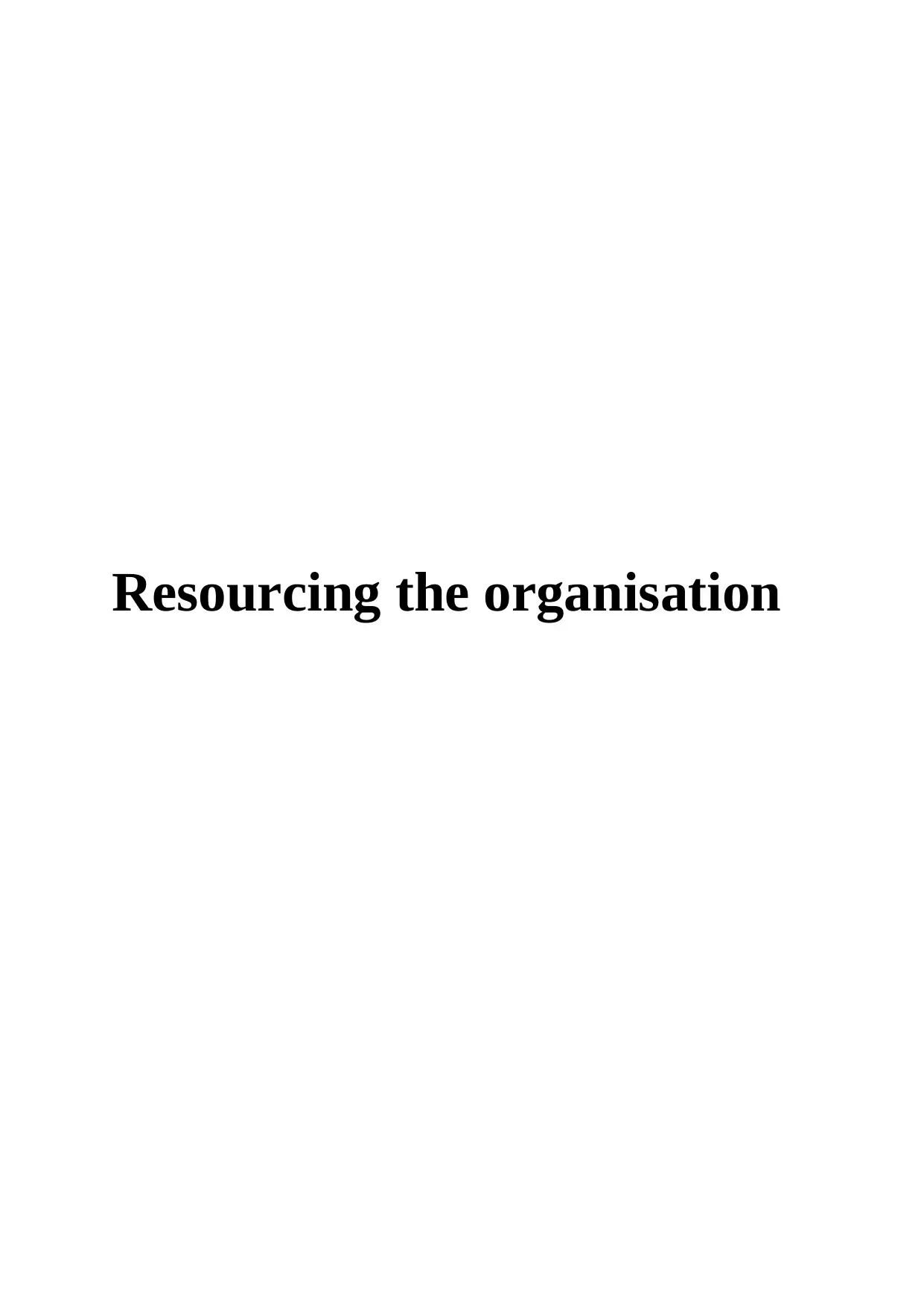
Resourcing the organisation
Paraphrase This Document
Need a fresh take? Get an instant paraphrase of this document with our AI Paraphraser
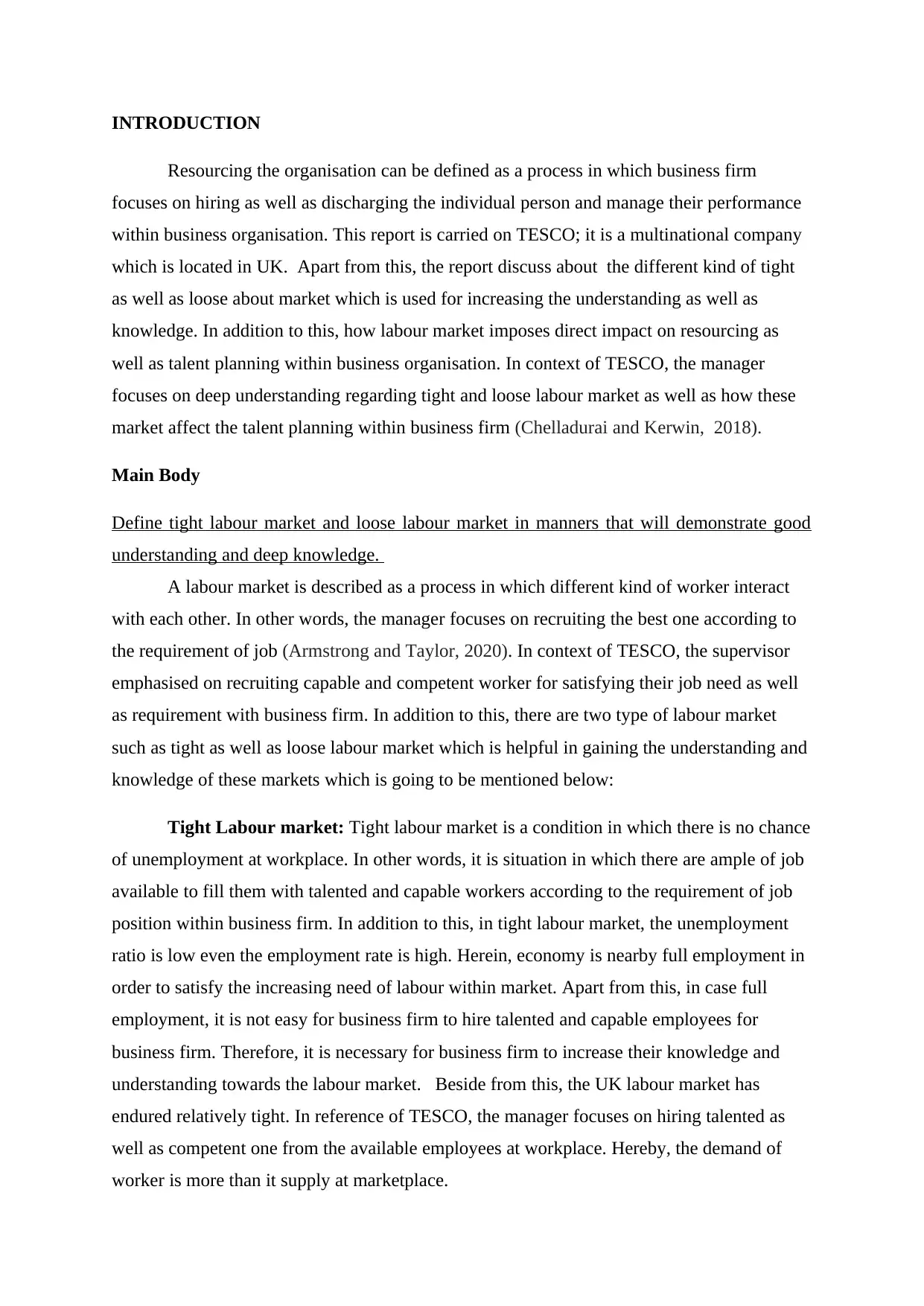
INTRODUCTION
Resourcing the organisation can be defined as a process in which business firm
focuses on hiring as well as discharging the individual person and manage their performance
within business organisation. This report is carried on TESCO; it is a multinational company
which is located in UK. Apart from this, the report discuss about the different kind of tight
as well as loose about market which is used for increasing the understanding as well as
knowledge. In addition to this, how labour market imposes direct impact on resourcing as
well as talent planning within business organisation. In context of TESCO, the manager
focuses on deep understanding regarding tight and loose labour market as well as how these
market affect the talent planning within business firm (Chelladurai and Kerwin, 2018).
Main Body
Define tight labour market and loose labour market in manners that will demonstrate good
understanding and deep knowledge.
A labour market is described as a process in which different kind of worker interact
with each other. In other words, the manager focuses on recruiting the best one according to
the requirement of job (Armstrong and Taylor, 2020). In context of TESCO, the supervisor
emphasised on recruiting capable and competent worker for satisfying their job need as well
as requirement with business firm. In addition to this, there are two type of labour market
such as tight as well as loose labour market which is helpful in gaining the understanding and
knowledge of these markets which is going to be mentioned below:
Tight Labour market: Tight labour market is a condition in which there is no chance
of unemployment at workplace. In other words, it is situation in which there are ample of job
available to fill them with talented and capable workers according to the requirement of job
position within business firm. In addition to this, in tight labour market, the unemployment
ratio is low even the employment rate is high. Herein, economy is nearby full employment in
order to satisfy the increasing need of labour within market. Apart from this, in case full
employment, it is not easy for business firm to hire talented and capable employees for
business firm. Therefore, it is necessary for business firm to increase their knowledge and
understanding towards the labour market. Beside from this, the UK labour market has
endured relatively tight. In reference of TESCO, the manager focuses on hiring talented as
well as competent one from the available employees at workplace. Hereby, the demand of
worker is more than it supply at marketplace.
Resourcing the organisation can be defined as a process in which business firm
focuses on hiring as well as discharging the individual person and manage their performance
within business organisation. This report is carried on TESCO; it is a multinational company
which is located in UK. Apart from this, the report discuss about the different kind of tight
as well as loose about market which is used for increasing the understanding as well as
knowledge. In addition to this, how labour market imposes direct impact on resourcing as
well as talent planning within business organisation. In context of TESCO, the manager
focuses on deep understanding regarding tight and loose labour market as well as how these
market affect the talent planning within business firm (Chelladurai and Kerwin, 2018).
Main Body
Define tight labour market and loose labour market in manners that will demonstrate good
understanding and deep knowledge.
A labour market is described as a process in which different kind of worker interact
with each other. In other words, the manager focuses on recruiting the best one according to
the requirement of job (Armstrong and Taylor, 2020). In context of TESCO, the supervisor
emphasised on recruiting capable and competent worker for satisfying their job need as well
as requirement with business firm. In addition to this, there are two type of labour market
such as tight as well as loose labour market which is helpful in gaining the understanding and
knowledge of these markets which is going to be mentioned below:
Tight Labour market: Tight labour market is a condition in which there is no chance
of unemployment at workplace. In other words, it is situation in which there are ample of job
available to fill them with talented and capable workers according to the requirement of job
position within business firm. In addition to this, in tight labour market, the unemployment
ratio is low even the employment rate is high. Herein, economy is nearby full employment in
order to satisfy the increasing need of labour within market. Apart from this, in case full
employment, it is not easy for business firm to hire talented and capable employees for
business firm. Therefore, it is necessary for business firm to increase their knowledge and
understanding towards the labour market. Beside from this, the UK labour market has
endured relatively tight. In reference of TESCO, the manager focuses on hiring talented as
well as competent one from the available employees at workplace. Hereby, the demand of
worker is more than it supply at marketplace.
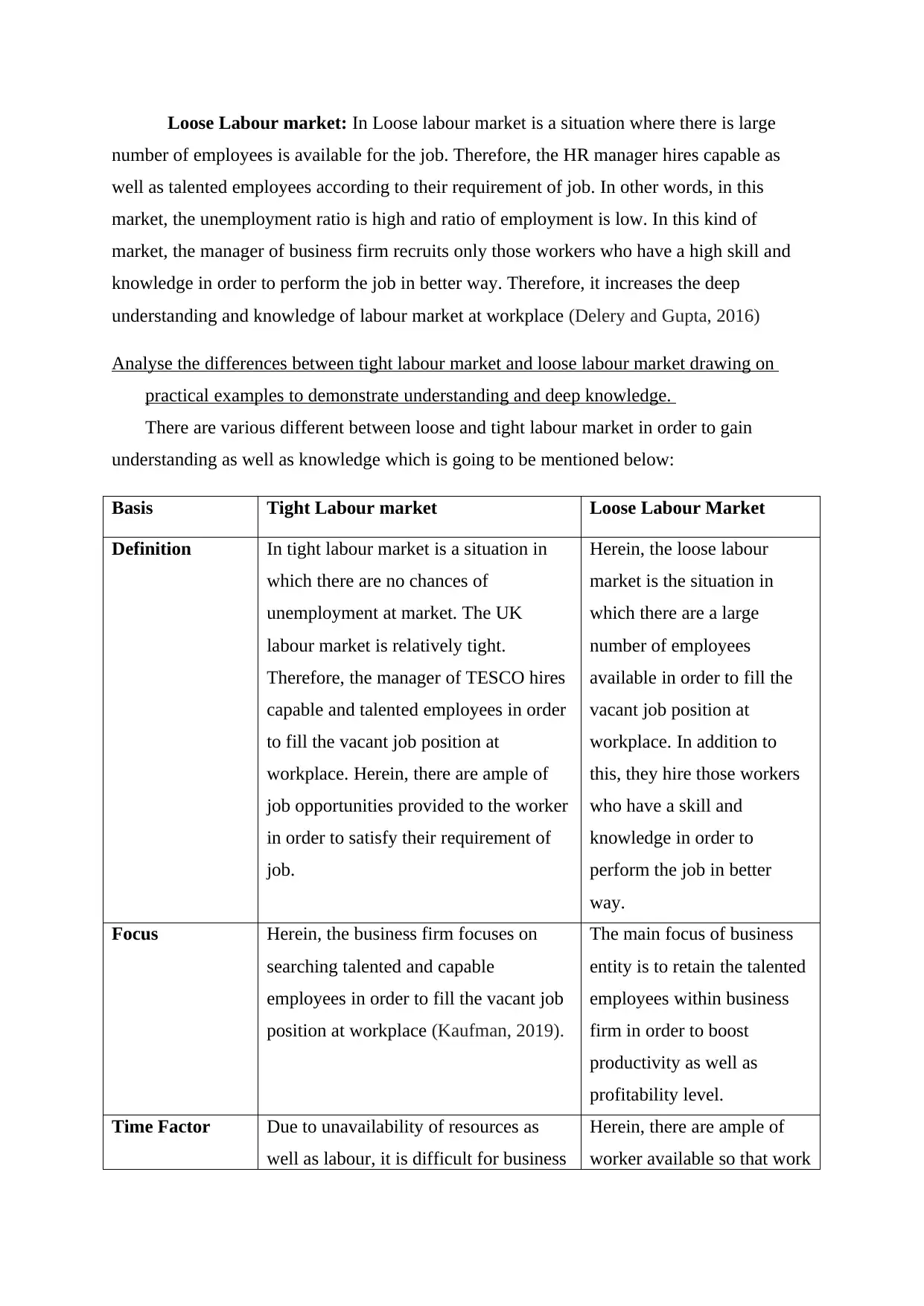
Loose Labour market: In Loose labour market is a situation where there is large
number of employees is available for the job. Therefore, the HR manager hires capable as
well as talented employees according to their requirement of job. In other words, in this
market, the unemployment ratio is high and ratio of employment is low. In this kind of
market, the manager of business firm recruits only those workers who have a high skill and
knowledge in order to perform the job in better way. Therefore, it increases the deep
understanding and knowledge of labour market at workplace (Delery and Gupta, 2016)
Analyse the differences between tight labour market and loose labour market drawing on
practical examples to demonstrate understanding and deep knowledge.
There are various different between loose and tight labour market in order to gain
understanding as well as knowledge which is going to be mentioned below:
Basis Tight Labour market Loose Labour Market
Definition In tight labour market is a situation in
which there are no chances of
unemployment at market. The UK
labour market is relatively tight.
Therefore, the manager of TESCO hires
capable and talented employees in order
to fill the vacant job position at
workplace. Herein, there are ample of
job opportunities provided to the worker
in order to satisfy their requirement of
job.
Herein, the loose labour
market is the situation in
which there are a large
number of employees
available in order to fill the
vacant job position at
workplace. In addition to
this, they hire those workers
who have a skill and
knowledge in order to
perform the job in better
way.
Focus Herein, the business firm focuses on
searching talented and capable
employees in order to fill the vacant job
position at workplace (Kaufman, 2019).
The main focus of business
entity is to retain the talented
employees within business
firm in order to boost
productivity as well as
profitability level.
Time Factor Due to unavailability of resources as
well as labour, it is difficult for business
Herein, there are ample of
worker available so that work
number of employees is available for the job. Therefore, the HR manager hires capable as
well as talented employees according to their requirement of job. In other words, in this
market, the unemployment ratio is high and ratio of employment is low. In this kind of
market, the manager of business firm recruits only those workers who have a high skill and
knowledge in order to perform the job in better way. Therefore, it increases the deep
understanding and knowledge of labour market at workplace (Delery and Gupta, 2016)
Analyse the differences between tight labour market and loose labour market drawing on
practical examples to demonstrate understanding and deep knowledge.
There are various different between loose and tight labour market in order to gain
understanding as well as knowledge which is going to be mentioned below:
Basis Tight Labour market Loose Labour Market
Definition In tight labour market is a situation in
which there are no chances of
unemployment at market. The UK
labour market is relatively tight.
Therefore, the manager of TESCO hires
capable and talented employees in order
to fill the vacant job position at
workplace. Herein, there are ample of
job opportunities provided to the worker
in order to satisfy their requirement of
job.
Herein, the loose labour
market is the situation in
which there are a large
number of employees
available in order to fill the
vacant job position at
workplace. In addition to
this, they hire those workers
who have a skill and
knowledge in order to
perform the job in better
way.
Focus Herein, the business firm focuses on
searching talented and capable
employees in order to fill the vacant job
position at workplace (Kaufman, 2019).
The main focus of business
entity is to retain the talented
employees within business
firm in order to boost
productivity as well as
profitability level.
Time Factor Due to unavailability of resources as
well as labour, it is difficult for business
Herein, there are ample of
worker available so that work
⊘ This is a preview!⊘
Do you want full access?
Subscribe today to unlock all pages.

Trusted by 1+ million students worldwide
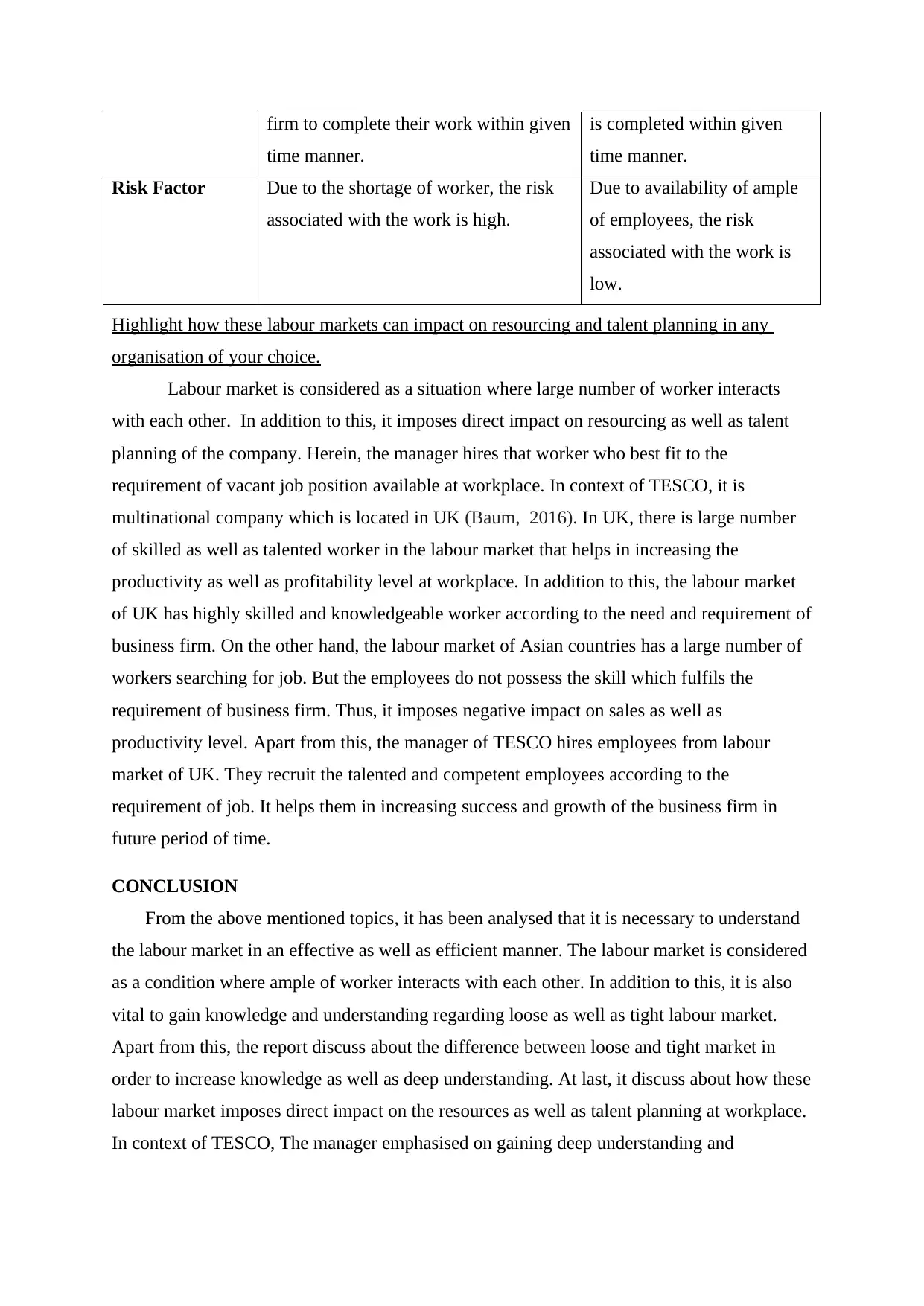
firm to complete their work within given
time manner.
is completed within given
time manner.
Risk Factor Due to the shortage of worker, the risk
associated with the work is high.
Due to availability of ample
of employees, the risk
associated with the work is
low.
Highlight how these labour markets can impact on resourcing and talent planning in any
organisation of your choice.
Labour market is considered as a situation where large number of worker interacts
with each other. In addition to this, it imposes direct impact on resourcing as well as talent
planning of the company. Herein, the manager hires that worker who best fit to the
requirement of vacant job position available at workplace. In context of TESCO, it is
multinational company which is located in UK (Baum, 2016). In UK, there is large number
of skilled as well as talented worker in the labour market that helps in increasing the
productivity as well as profitability level at workplace. In addition to this, the labour market
of UK has highly skilled and knowledgeable worker according to the need and requirement of
business firm. On the other hand, the labour market of Asian countries has a large number of
workers searching for job. But the employees do not possess the skill which fulfils the
requirement of business firm. Thus, it imposes negative impact on sales as well as
productivity level. Apart from this, the manager of TESCO hires employees from labour
market of UK. They recruit the talented and competent employees according to the
requirement of job. It helps them in increasing success and growth of the business firm in
future period of time.
CONCLUSION
From the above mentioned topics, it has been analysed that it is necessary to understand
the labour market in an effective as well as efficient manner. The labour market is considered
as a condition where ample of worker interacts with each other. In addition to this, it is also
vital to gain knowledge and understanding regarding loose as well as tight labour market.
Apart from this, the report discuss about the difference between loose and tight market in
order to increase knowledge as well as deep understanding. At last, it discuss about how these
labour market imposes direct impact on the resources as well as talent planning at workplace.
In context of TESCO, The manager emphasised on gaining deep understanding and
time manner.
is completed within given
time manner.
Risk Factor Due to the shortage of worker, the risk
associated with the work is high.
Due to availability of ample
of employees, the risk
associated with the work is
low.
Highlight how these labour markets can impact on resourcing and talent planning in any
organisation of your choice.
Labour market is considered as a situation where large number of worker interacts
with each other. In addition to this, it imposes direct impact on resourcing as well as talent
planning of the company. Herein, the manager hires that worker who best fit to the
requirement of vacant job position available at workplace. In context of TESCO, it is
multinational company which is located in UK (Baum, 2016). In UK, there is large number
of skilled as well as talented worker in the labour market that helps in increasing the
productivity as well as profitability level at workplace. In addition to this, the labour market
of UK has highly skilled and knowledgeable worker according to the need and requirement of
business firm. On the other hand, the labour market of Asian countries has a large number of
workers searching for job. But the employees do not possess the skill which fulfils the
requirement of business firm. Thus, it imposes negative impact on sales as well as
productivity level. Apart from this, the manager of TESCO hires employees from labour
market of UK. They recruit the talented and competent employees according to the
requirement of job. It helps them in increasing success and growth of the business firm in
future period of time.
CONCLUSION
From the above mentioned topics, it has been analysed that it is necessary to understand
the labour market in an effective as well as efficient manner. The labour market is considered
as a condition where ample of worker interacts with each other. In addition to this, it is also
vital to gain knowledge and understanding regarding loose as well as tight labour market.
Apart from this, the report discuss about the difference between loose and tight market in
order to increase knowledge as well as deep understanding. At last, it discuss about how these
labour market imposes direct impact on the resources as well as talent planning at workplace.
In context of TESCO, The manager emphasised on gaining deep understanding and
Paraphrase This Document
Need a fresh take? Get an instant paraphrase of this document with our AI Paraphraser
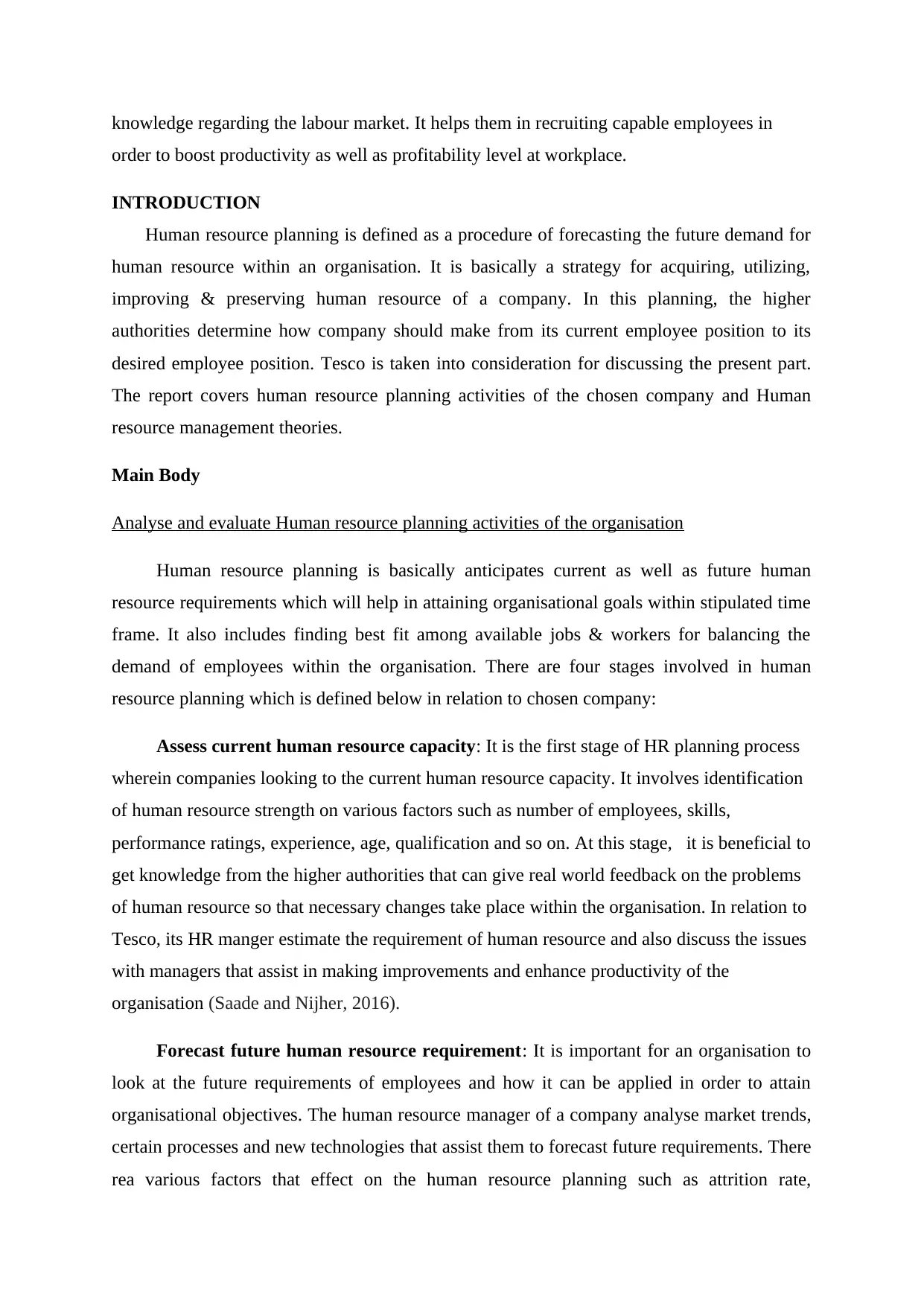
knowledge regarding the labour market. It helps them in recruiting capable employees in
order to boost productivity as well as profitability level at workplace.
INTRODUCTION
Human resource planning is defined as a procedure of forecasting the future demand for
human resource within an organisation. It is basically a strategy for acquiring, utilizing,
improving & preserving human resource of a company. In this planning, the higher
authorities determine how company should make from its current employee position to its
desired employee position. Tesco is taken into consideration for discussing the present part.
The report covers human resource planning activities of the chosen company and Human
resource management theories.
Main Body
Analyse and evaluate Human resource planning activities of the organisation
Human resource planning is basically anticipates current as well as future human
resource requirements which will help in attaining organisational goals within stipulated time
frame. It also includes finding best fit among available jobs & workers for balancing the
demand of employees within the organisation. There are four stages involved in human
resource planning which is defined below in relation to chosen company:
Assess current human resource capacity: It is the first stage of HR planning process
wherein companies looking to the current human resource capacity. It involves identification
of human resource strength on various factors such as number of employees, skills,
performance ratings, experience, age, qualification and so on. At this stage, it is beneficial to
get knowledge from the higher authorities that can give real world feedback on the problems
of human resource so that necessary changes take place within the organisation. In relation to
Tesco, its HR manger estimate the requirement of human resource and also discuss the issues
with managers that assist in making improvements and enhance productivity of the
organisation (Saade and Nijher, 2016).
Forecast future human resource requirement: It is important for an organisation to
look at the future requirements of employees and how it can be applied in order to attain
organisational objectives. The human resource manager of a company analyse market trends,
certain processes and new technologies that assist them to forecast future requirements. There
rea various factors that effect on the human resource planning such as attrition rate,
order to boost productivity as well as profitability level at workplace.
INTRODUCTION
Human resource planning is defined as a procedure of forecasting the future demand for
human resource within an organisation. It is basically a strategy for acquiring, utilizing,
improving & preserving human resource of a company. In this planning, the higher
authorities determine how company should make from its current employee position to its
desired employee position. Tesco is taken into consideration for discussing the present part.
The report covers human resource planning activities of the chosen company and Human
resource management theories.
Main Body
Analyse and evaluate Human resource planning activities of the organisation
Human resource planning is basically anticipates current as well as future human
resource requirements which will help in attaining organisational goals within stipulated time
frame. It also includes finding best fit among available jobs & workers for balancing the
demand of employees within the organisation. There are four stages involved in human
resource planning which is defined below in relation to chosen company:
Assess current human resource capacity: It is the first stage of HR planning process
wherein companies looking to the current human resource capacity. It involves identification
of human resource strength on various factors such as number of employees, skills,
performance ratings, experience, age, qualification and so on. At this stage, it is beneficial to
get knowledge from the higher authorities that can give real world feedback on the problems
of human resource so that necessary changes take place within the organisation. In relation to
Tesco, its HR manger estimate the requirement of human resource and also discuss the issues
with managers that assist in making improvements and enhance productivity of the
organisation (Saade and Nijher, 2016).
Forecast future human resource requirement: It is important for an organisation to
look at the future requirements of employees and how it can be applied in order to attain
organisational objectives. The human resource manager of a company analyse market trends,
certain processes and new technologies that assist them to forecast future requirements. There
rea various factors that effect on the human resource planning such as attrition rate,
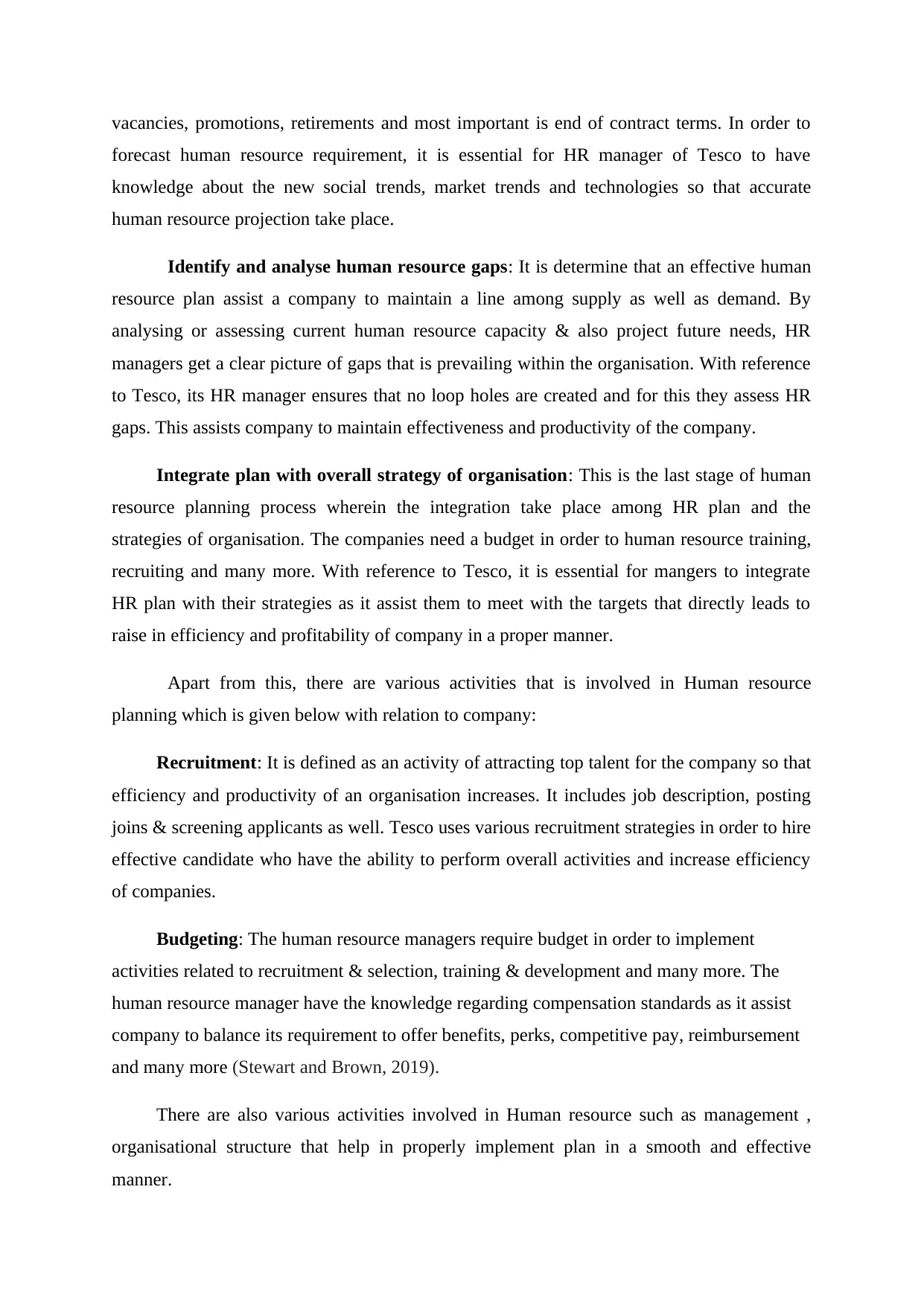
vacancies, promotions, retirements and most important is end of contract terms. In order to
forecast human resource requirement, it is essential for HR manager of Tesco to have
knowledge about the new social trends, market trends and technologies so that accurate
human resource projection take place.
Identify and analyse human resource gaps: It is determine that an effective human
resource plan assist a company to maintain a line among supply as well as demand. By
analysing or assessing current human resource capacity & also project future needs, HR
managers get a clear picture of gaps that is prevailing within the organisation. With reference
to Tesco, its HR manager ensures that no loop holes are created and for this they assess HR
gaps. This assists company to maintain effectiveness and productivity of the company.
Integrate plan with overall strategy of organisation: This is the last stage of human
resource planning process wherein the integration take place among HR plan and the
strategies of organisation. The companies need a budget in order to human resource training,
recruiting and many more. With reference to Tesco, it is essential for mangers to integrate
HR plan with their strategies as it assist them to meet with the targets that directly leads to
raise in efficiency and profitability of company in a proper manner.
Apart from this, there are various activities that is involved in Human resource
planning which is given below with relation to company:
Recruitment: It is defined as an activity of attracting top talent for the company so that
efficiency and productivity of an organisation increases. It includes job description, posting
joins & screening applicants as well. Tesco uses various recruitment strategies in order to hire
effective candidate who have the ability to perform overall activities and increase efficiency
of companies.
Budgeting: The human resource managers require budget in order to implement
activities related to recruitment & selection, training & development and many more. The
human resource manager have the knowledge regarding compensation standards as it assist
company to balance its requirement to offer benefits, perks, competitive pay, reimbursement
and many more (Stewart and Brown, 2019).
There are also various activities involved in Human resource such as management ,
organisational structure that help in properly implement plan in a smooth and effective
manner.
forecast human resource requirement, it is essential for HR manager of Tesco to have
knowledge about the new social trends, market trends and technologies so that accurate
human resource projection take place.
Identify and analyse human resource gaps: It is determine that an effective human
resource plan assist a company to maintain a line among supply as well as demand. By
analysing or assessing current human resource capacity & also project future needs, HR
managers get a clear picture of gaps that is prevailing within the organisation. With reference
to Tesco, its HR manager ensures that no loop holes are created and for this they assess HR
gaps. This assists company to maintain effectiveness and productivity of the company.
Integrate plan with overall strategy of organisation: This is the last stage of human
resource planning process wherein the integration take place among HR plan and the
strategies of organisation. The companies need a budget in order to human resource training,
recruiting and many more. With reference to Tesco, it is essential for mangers to integrate
HR plan with their strategies as it assist them to meet with the targets that directly leads to
raise in efficiency and profitability of company in a proper manner.
Apart from this, there are various activities that is involved in Human resource
planning which is given below with relation to company:
Recruitment: It is defined as an activity of attracting top talent for the company so that
efficiency and productivity of an organisation increases. It includes job description, posting
joins & screening applicants as well. Tesco uses various recruitment strategies in order to hire
effective candidate who have the ability to perform overall activities and increase efficiency
of companies.
Budgeting: The human resource managers require budget in order to implement
activities related to recruitment & selection, training & development and many more. The
human resource manager have the knowledge regarding compensation standards as it assist
company to balance its requirement to offer benefits, perks, competitive pay, reimbursement
and many more (Stewart and Brown, 2019).
There are also various activities involved in Human resource such as management ,
organisational structure that help in properly implement plan in a smooth and effective
manner.
⊘ This is a preview!⊘
Do you want full access?
Subscribe today to unlock all pages.

Trusted by 1+ million students worldwide
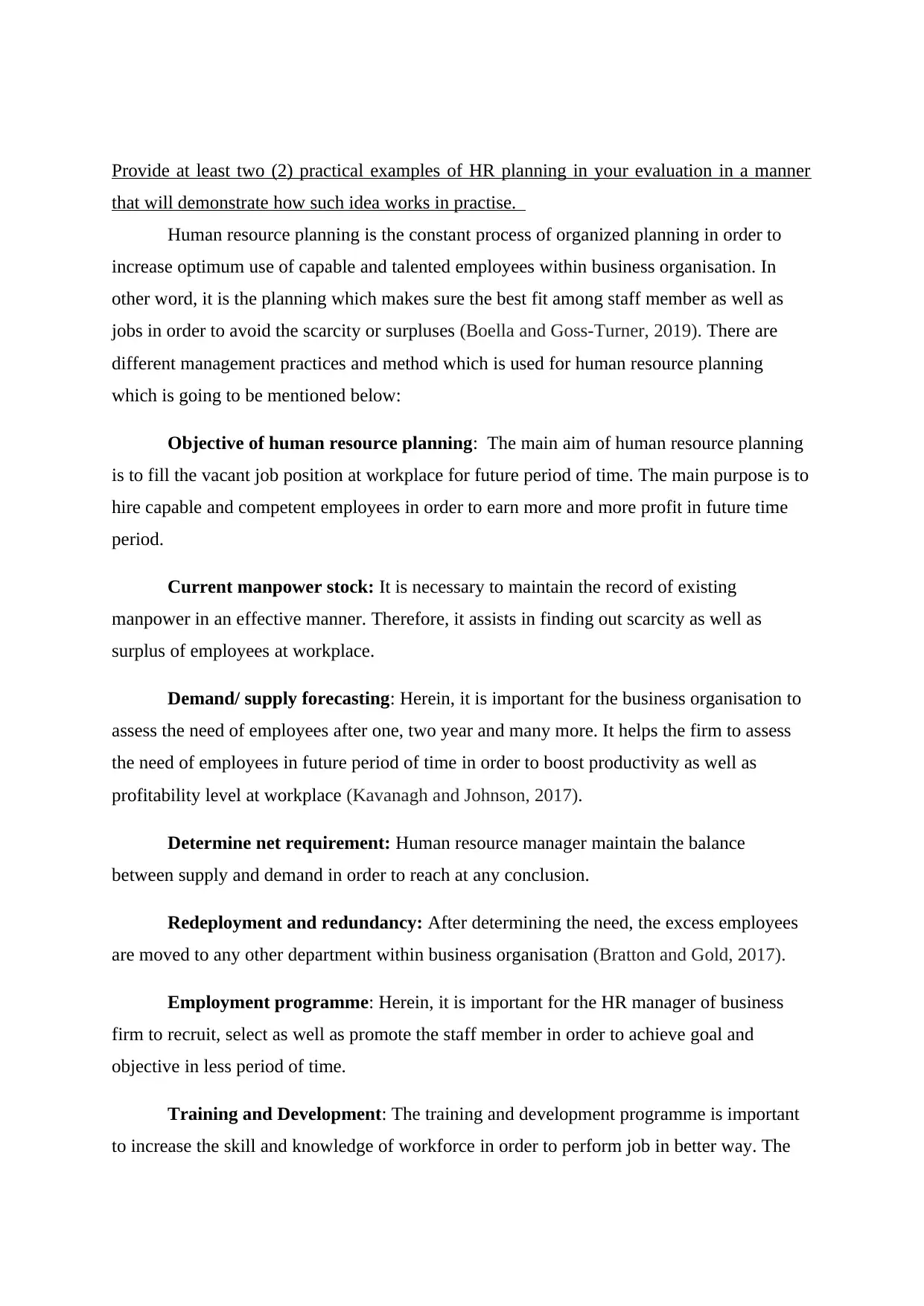
Provide at least two (2) practical examples of HR planning in your evaluation in a manner
that will demonstrate how such idea works in practise.
Human resource planning is the constant process of organized planning in order to
increase optimum use of capable and talented employees within business organisation. In
other word, it is the planning which makes sure the best fit among staff member as well as
jobs in order to avoid the scarcity or surpluses (Boella and Goss-Turner, 2019). There are
different management practices and method which is used for human resource planning
which is going to be mentioned below:
Objective of human resource planning: The main aim of human resource planning
is to fill the vacant job position at workplace for future period of time. The main purpose is to
hire capable and competent employees in order to earn more and more profit in future time
period.
Current manpower stock: It is necessary to maintain the record of existing
manpower in an effective manner. Therefore, it assists in finding out scarcity as well as
surplus of employees at workplace.
Demand/ supply forecasting: Herein, it is important for the business organisation to
assess the need of employees after one, two year and many more. It helps the firm to assess
the need of employees in future period of time in order to boost productivity as well as
profitability level at workplace (Kavanagh and Johnson, 2017).
Determine net requirement: Human resource manager maintain the balance
between supply and demand in order to reach at any conclusion.
Redeployment and redundancy: After determining the need, the excess employees
are moved to any other department within business organisation (Bratton and Gold, 2017).
Employment programme: Herein, it is important for the HR manager of business
firm to recruit, select as well as promote the staff member in order to achieve goal and
objective in less period of time.
Training and Development: The training and development programme is important
to increase the skill and knowledge of workforce in order to perform job in better way. The
that will demonstrate how such idea works in practise.
Human resource planning is the constant process of organized planning in order to
increase optimum use of capable and talented employees within business organisation. In
other word, it is the planning which makes sure the best fit among staff member as well as
jobs in order to avoid the scarcity or surpluses (Boella and Goss-Turner, 2019). There are
different management practices and method which is used for human resource planning
which is going to be mentioned below:
Objective of human resource planning: The main aim of human resource planning
is to fill the vacant job position at workplace for future period of time. The main purpose is to
hire capable and competent employees in order to earn more and more profit in future time
period.
Current manpower stock: It is necessary to maintain the record of existing
manpower in an effective manner. Therefore, it assists in finding out scarcity as well as
surplus of employees at workplace.
Demand/ supply forecasting: Herein, it is important for the business organisation to
assess the need of employees after one, two year and many more. It helps the firm to assess
the need of employees in future period of time in order to boost productivity as well as
profitability level at workplace (Kavanagh and Johnson, 2017).
Determine net requirement: Human resource manager maintain the balance
between supply and demand in order to reach at any conclusion.
Redeployment and redundancy: After determining the need, the excess employees
are moved to any other department within business organisation (Bratton and Gold, 2017).
Employment programme: Herein, it is important for the HR manager of business
firm to recruit, select as well as promote the staff member in order to achieve goal and
objective in less period of time.
Training and Development: The training and development programme is important
to increase the skill and knowledge of workforce in order to perform job in better way. The
Paraphrase This Document
Need a fresh take? Get an instant paraphrase of this document with our AI Paraphraser
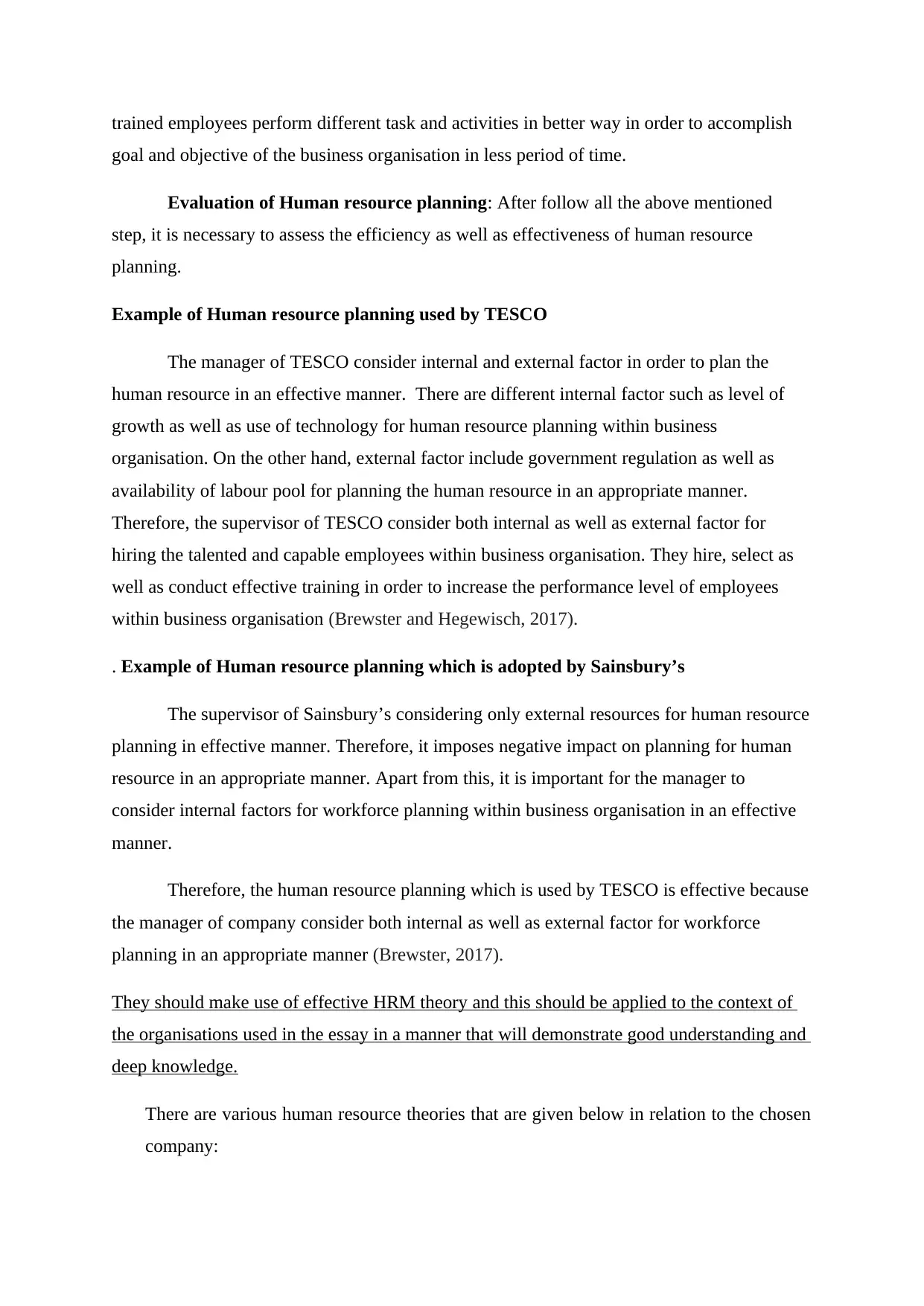
trained employees perform different task and activities in better way in order to accomplish
goal and objective of the business organisation in less period of time.
Evaluation of Human resource planning: After follow all the above mentioned
step, it is necessary to assess the efficiency as well as effectiveness of human resource
planning.
Example of Human resource planning used by TESCO
The manager of TESCO consider internal and external factor in order to plan the
human resource in an effective manner. There are different internal factor such as level of
growth as well as use of technology for human resource planning within business
organisation. On the other hand, external factor include government regulation as well as
availability of labour pool for planning the human resource in an appropriate manner.
Therefore, the supervisor of TESCO consider both internal as well as external factor for
hiring the talented and capable employees within business organisation. They hire, select as
well as conduct effective training in order to increase the performance level of employees
within business organisation (Brewster and Hegewisch, 2017).
. Example of Human resource planning which is adopted by Sainsbury’s
The supervisor of Sainsbury’s considering only external resources for human resource
planning in effective manner. Therefore, it imposes negative impact on planning for human
resource in an appropriate manner. Apart from this, it is important for the manager to
consider internal factors for workforce planning within business organisation in an effective
manner.
Therefore, the human resource planning which is used by TESCO is effective because
the manager of company consider both internal as well as external factor for workforce
planning in an appropriate manner (Brewster, 2017).
They should make use of effective HRM theory and this should be applied to the context of
the organisations used in the essay in a manner that will demonstrate good understanding and
deep knowledge.
There are various human resource theories that are given below in relation to the chosen
company:
goal and objective of the business organisation in less period of time.
Evaluation of Human resource planning: After follow all the above mentioned
step, it is necessary to assess the efficiency as well as effectiveness of human resource
planning.
Example of Human resource planning used by TESCO
The manager of TESCO consider internal and external factor in order to plan the
human resource in an effective manner. There are different internal factor such as level of
growth as well as use of technology for human resource planning within business
organisation. On the other hand, external factor include government regulation as well as
availability of labour pool for planning the human resource in an appropriate manner.
Therefore, the supervisor of TESCO consider both internal as well as external factor for
hiring the talented and capable employees within business organisation. They hire, select as
well as conduct effective training in order to increase the performance level of employees
within business organisation (Brewster and Hegewisch, 2017).
. Example of Human resource planning which is adopted by Sainsbury’s
The supervisor of Sainsbury’s considering only external resources for human resource
planning in effective manner. Therefore, it imposes negative impact on planning for human
resource in an appropriate manner. Apart from this, it is important for the manager to
consider internal factors for workforce planning within business organisation in an effective
manner.
Therefore, the human resource planning which is used by TESCO is effective because
the manager of company consider both internal as well as external factor for workforce
planning in an appropriate manner (Brewster, 2017).
They should make use of effective HRM theory and this should be applied to the context of
the organisations used in the essay in a manner that will demonstrate good understanding and
deep knowledge.
There are various human resource theories that are given below in relation to the chosen
company:
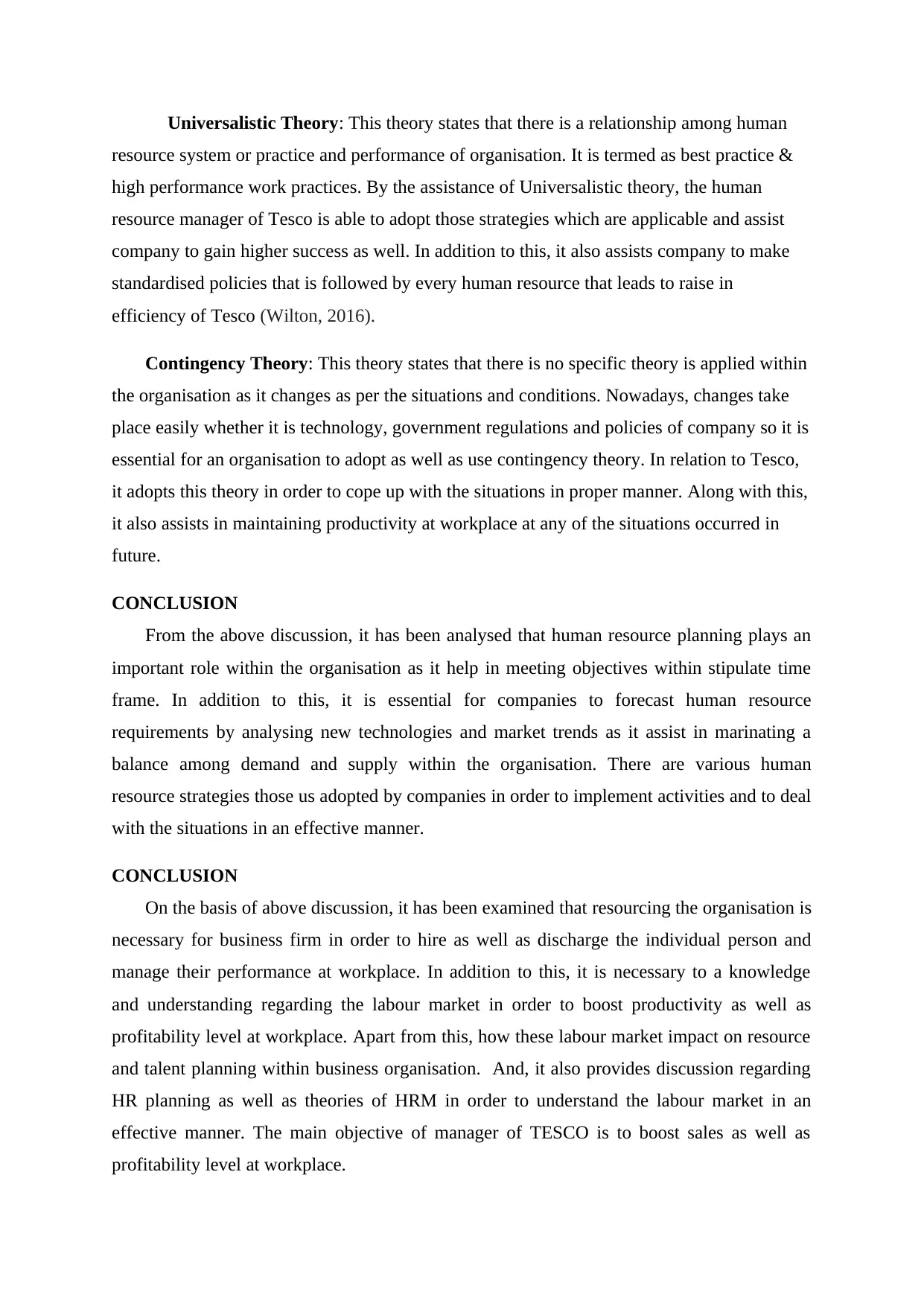
Universalistic Theory: This theory states that there is a relationship among human
resource system or practice and performance of organisation. It is termed as best practice &
high performance work practices. By the assistance of Universalistic theory, the human
resource manager of Tesco is able to adopt those strategies which are applicable and assist
company to gain higher success as well. In addition to this, it also assists company to make
standardised policies that is followed by every human resource that leads to raise in
efficiency of Tesco (Wilton, 2016).
Contingency Theory: This theory states that there is no specific theory is applied within
the organisation as it changes as per the situations and conditions. Nowadays, changes take
place easily whether it is technology, government regulations and policies of company so it is
essential for an organisation to adopt as well as use contingency theory. In relation to Tesco,
it adopts this theory in order to cope up with the situations in proper manner. Along with this,
it also assists in maintaining productivity at workplace at any of the situations occurred in
future.
CONCLUSION
From the above discussion, it has been analysed that human resource planning plays an
important role within the organisation as it help in meeting objectives within stipulate time
frame. In addition to this, it is essential for companies to forecast human resource
requirements by analysing new technologies and market trends as it assist in marinating a
balance among demand and supply within the organisation. There are various human
resource strategies those us adopted by companies in order to implement activities and to deal
with the situations in an effective manner.
CONCLUSION
On the basis of above discussion, it has been examined that resourcing the organisation is
necessary for business firm in order to hire as well as discharge the individual person and
manage their performance at workplace. In addition to this, it is necessary to a knowledge
and understanding regarding the labour market in order to boost productivity as well as
profitability level at workplace. Apart from this, how these labour market impact on resource
and talent planning within business organisation. And, it also provides discussion regarding
HR planning as well as theories of HRM in order to understand the labour market in an
effective manner. The main objective of manager of TESCO is to boost sales as well as
profitability level at workplace.
resource system or practice and performance of organisation. It is termed as best practice &
high performance work practices. By the assistance of Universalistic theory, the human
resource manager of Tesco is able to adopt those strategies which are applicable and assist
company to gain higher success as well. In addition to this, it also assists company to make
standardised policies that is followed by every human resource that leads to raise in
efficiency of Tesco (Wilton, 2016).
Contingency Theory: This theory states that there is no specific theory is applied within
the organisation as it changes as per the situations and conditions. Nowadays, changes take
place easily whether it is technology, government regulations and policies of company so it is
essential for an organisation to adopt as well as use contingency theory. In relation to Tesco,
it adopts this theory in order to cope up with the situations in proper manner. Along with this,
it also assists in maintaining productivity at workplace at any of the situations occurred in
future.
CONCLUSION
From the above discussion, it has been analysed that human resource planning plays an
important role within the organisation as it help in meeting objectives within stipulate time
frame. In addition to this, it is essential for companies to forecast human resource
requirements by analysing new technologies and market trends as it assist in marinating a
balance among demand and supply within the organisation. There are various human
resource strategies those us adopted by companies in order to implement activities and to deal
with the situations in an effective manner.
CONCLUSION
On the basis of above discussion, it has been examined that resourcing the organisation is
necessary for business firm in order to hire as well as discharge the individual person and
manage their performance at workplace. In addition to this, it is necessary to a knowledge
and understanding regarding the labour market in order to boost productivity as well as
profitability level at workplace. Apart from this, how these labour market impact on resource
and talent planning within business organisation. And, it also provides discussion regarding
HR planning as well as theories of HRM in order to understand the labour market in an
effective manner. The main objective of manager of TESCO is to boost sales as well as
profitability level at workplace.
⊘ This is a preview!⊘
Do you want full access?
Subscribe today to unlock all pages.

Trusted by 1+ million students worldwide
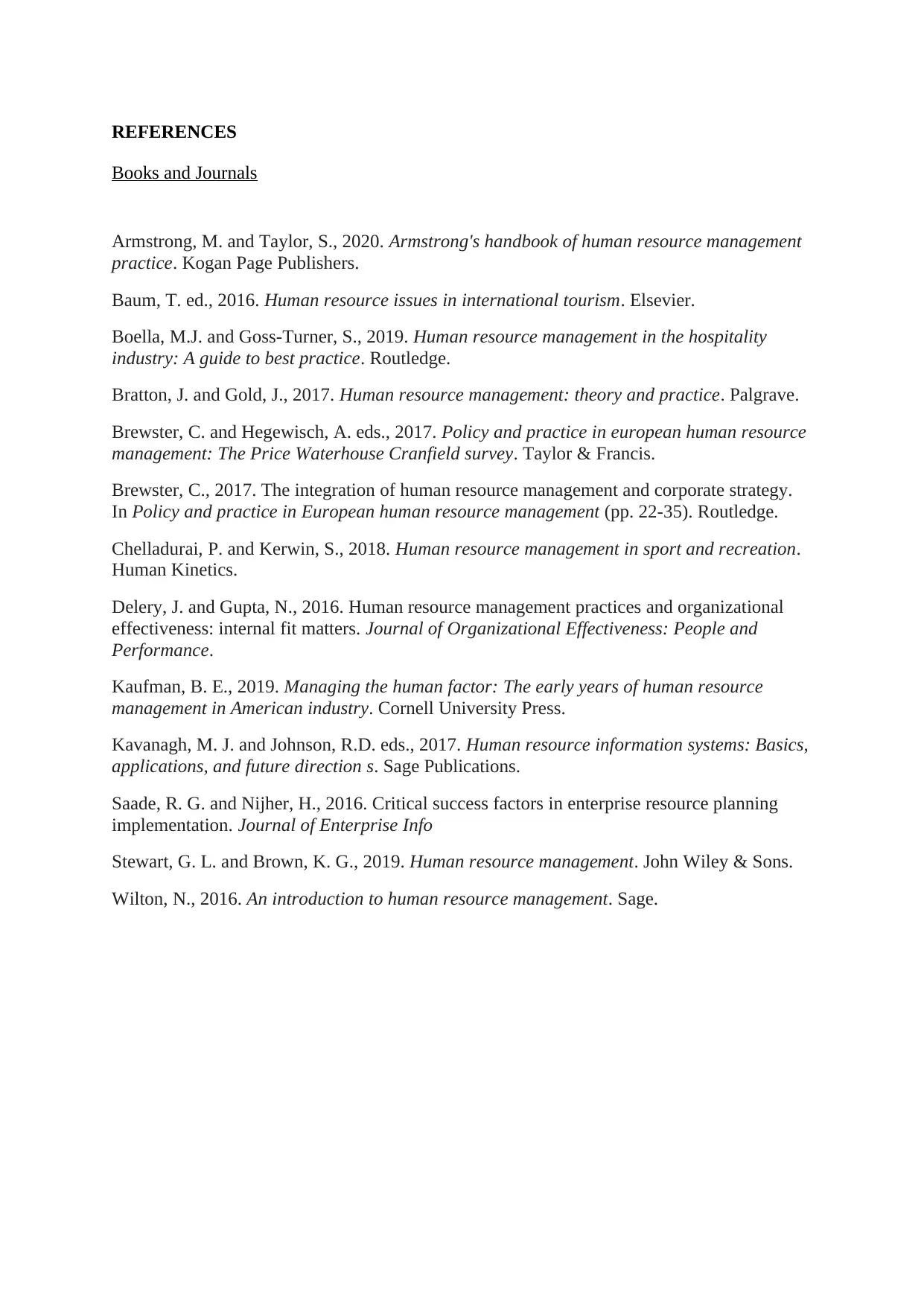
REFERENCES
Books and Journals
Armstrong, M. and Taylor, S., 2020. Armstrong's handbook of human resource management
practice. Kogan Page Publishers.
Baum, T. ed., 2016. Human resource issues in international tourism. Elsevier.
Boella, M.J. and Goss-Turner, S., 2019. Human resource management in the hospitality
industry: A guide to best practice. Routledge.
Bratton, J. and Gold, J., 2017. Human resource management: theory and practice. Palgrave.
Brewster, C. and Hegewisch, A. eds., 2017. Policy and practice in european human resource
management: The Price Waterhouse Cranfield survey. Taylor & Francis.
Brewster, C., 2017. The integration of human resource management and corporate strategy.
In Policy and practice in European human resource management (pp. 22-35). Routledge.
Chelladurai, P. and Kerwin, S., 2018. Human resource management in sport and recreation.
Human Kinetics.
Delery, J. and Gupta, N., 2016. Human resource management practices and organizational
effectiveness: internal fit matters. Journal of Organizational Effectiveness: People and
Performance.
Kaufman, B. E., 2019. Managing the human factor: The early years of human resource
management in American industry. Cornell University Press.
Kavanagh, M. J. and Johnson, R.D. eds., 2017. Human resource information systems: Basics,
applications, and future direction s. Sage Publications.
Saade, R. G. and Nijher, H., 2016. Critical success factors in enterprise resource planning
implementation. Journal of Enterprise Info
Stewart, G. L. and Brown, K. G., 2019. Human resource management. John Wiley & Sons.
Wilton, N., 2016. An introduction to human resource management. Sage.
Books and Journals
Armstrong, M. and Taylor, S., 2020. Armstrong's handbook of human resource management
practice. Kogan Page Publishers.
Baum, T. ed., 2016. Human resource issues in international tourism. Elsevier.
Boella, M.J. and Goss-Turner, S., 2019. Human resource management in the hospitality
industry: A guide to best practice. Routledge.
Bratton, J. and Gold, J., 2017. Human resource management: theory and practice. Palgrave.
Brewster, C. and Hegewisch, A. eds., 2017. Policy and practice in european human resource
management: The Price Waterhouse Cranfield survey. Taylor & Francis.
Brewster, C., 2017. The integration of human resource management and corporate strategy.
In Policy and practice in European human resource management (pp. 22-35). Routledge.
Chelladurai, P. and Kerwin, S., 2018. Human resource management in sport and recreation.
Human Kinetics.
Delery, J. and Gupta, N., 2016. Human resource management practices and organizational
effectiveness: internal fit matters. Journal of Organizational Effectiveness: People and
Performance.
Kaufman, B. E., 2019. Managing the human factor: The early years of human resource
management in American industry. Cornell University Press.
Kavanagh, M. J. and Johnson, R.D. eds., 2017. Human resource information systems: Basics,
applications, and future direction s. Sage Publications.
Saade, R. G. and Nijher, H., 2016. Critical success factors in enterprise resource planning
implementation. Journal of Enterprise Info
Stewart, G. L. and Brown, K. G., 2019. Human resource management. John Wiley & Sons.
Wilton, N., 2016. An introduction to human resource management. Sage.
Paraphrase This Document
Need a fresh take? Get an instant paraphrase of this document with our AI Paraphraser

1 out of 11
Related Documents
Your All-in-One AI-Powered Toolkit for Academic Success.
+13062052269
info@desklib.com
Available 24*7 on WhatsApp / Email
![[object Object]](/_next/static/media/star-bottom.7253800d.svg)
Unlock your academic potential
Copyright © 2020–2025 A2Z Services. All Rights Reserved. Developed and managed by ZUCOL.





